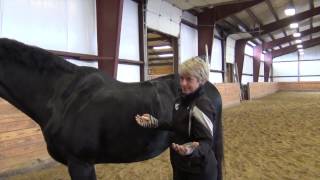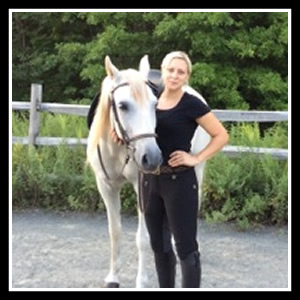Proper Saddle Fit

Good morning this is Will Faerber and Karen Loshbaugh from Art2Ride and we are coming to you from our clinic in Whitehouse, Ohio. Karen will now show us a little saddlefitting demonstration since we have had so many requests for it on our website.
Yesterday when we watched this horse it couldn’t move because the saddle was impeding the horse’s movement, especially in the shoulders. As a trainer, the last thing we want to do is make it difficult for the horse to perform what we are asking of him. They become unhappy and resentful because we are asking them to lift their back and carry themselves when their saddle is restricting them from doing that, which can be quite painful for them. So if you hit on certain areas of the horse’s back (which we call negative reflex points), the horse will hollow it’s back and move away from the pressure and that’s the last thing we want. We want the horse to push up through the back. It’s hard enough to get that to happen with some of the horses, so why would we ever want to impede them from doing that because of bad saddle fit? Bad saddle fit can cause so many problems including behavioral problems.
What Karen will now show us in the video are the 5 negative reflex points that you DO NOT want your saddle to be touching or activating on the horse because it will make him hollow his back. The first place is the shoulder: you find the edge of the scapula and the shoulder bone. When the horse’s leg goes forward the shoulder comes back, which you can see when you lunge your horse. If the shoulder comes back and is hitting the saddle they start to reach and it hits the saddle resulting in them pulling back. You never get the motion you are trying to achieve, and that is what we saw in this horse yesterday. It was very obvious that this horse was not willing to extend to the full range of motion because his shoulder was hitting on the saddle every time. Not a very happy position for the horse to be in.
The next area is along the spine: you have tendons and ligaments on each side of the spine and if the gullet of your saddle is too narrow it sits on top of those tendons and ligaments making your horse very very sore. I have seen horses so sore that they drop right away with the slightest touch on those spots. The long muscle however running along here (as shown in the video) is very supportive and is a good place for the saddle to sit, but not on the tendons and ligaments! You need to make sure that the gullet of your saddle (the space between the two panels) is wide enough for the horse. How wide does the gullet need to be? You can feel with your fingers where the tendons end and the muscle starts, it feels like a little shelf. You feel it on one side and them the other side and then you take your hand through there between those two spots and find the right width. This horse needs about a 4-5 finger gullet. After figuring that out, you should be able to take your saddle and run your hand through it finding the same width. Especially because every time the horse turns the saddle will shift a little bit to the outside and if you have a very narrow gullet your saddle sits right on top of that very sensitive area.
The next important thing about proper saddle fit is the length of the saddle. You have the thoracic vertebrae which the ribs are attached to which come down like this (as shown in video) and are very long. You DO NOT want to go past that last thoracic vertebrae! Where is it? You can feel it curving up and going up under the big longissimus muscle and ends up right there (see video). The easy way is to take where the hair comes together and draw a line straight up and you find that same place. That is a pretty short saddle support area. The reason for this is the wings of the lumbar vertebrae (right behind that place) are very short and very thin, making it not a good supportive area for a saddle. When the horse canters there is a lot of motion in the back in this area. If the horse goes to canter and pushes up and it hits the pressure of the saddle, they will hollow and buck and forebeat and won’t want to canter. It is very important to stay off this area!
The next area, which is rarely a problem, is where the ribs come out from underneath the longissimus muscle. We just don’t want a saddle to sit on ribs, but that rarely happens in an English saddle.
The last area, and also one of the most important, is the triangle area shown in the video, a hands width down from the withers. The reason for this is this is a totally different muscle, the trapezius muscle. This is the muscle that helps the horse lifts it’s neck and controls what the horse does with it’s neck. The horse has several reflex points, including one in that spot which will make the horse hollow it’s back, which we do not want at all. So it is very important to stay off of that point. The other thing we noticed when the horse was being ridden was it didn’t want to stretch, he would start but them immediately come back up. That can be a very good indication that as the horse’s neck goes down and the muscle widens it has no place to go, making it uncomfortable. He will start to go down because we asked him to, but them will feel the saddle and in pain will come back up. This horse could not find a comfortable spot and it was obvious that it was the saddle. We put a saddle on that stayed away from all these spots and the horse was happy! If the horse is happy, we are happy!
So if you remember the area your saddle needs to stay in your gold. If you start hitting these other areas, especially in the shoulder area, you can actually chip off the cartilage off of the shoulder bone! It’s not bone, it’s cartilage. Some horses have to be completely retired because of that cartilage chipping off. You have to think that the gullet of this saddle is steel, it is hard, the horse breaks but the saddle does not. If the saddle is laying too close here it continuously hits against the shoulder and will eventually start to chip it off.
Now that we have the chalk pattern shown on this horse, we will see how his saddle fits. What is the most obvious thing that we notice? It hits the shoulder and is way too long. This saddle is 5-6 inches too long. See how the saddle sits so closely up here? You want the saddle to sit open where you can easily slide your hand in because that is what the shoulder does. You need to have that space for the shoulder and for that trapezius muscle. Always trust the horse, if you would have seen this horse yesterday it would have made a believer out of you. The difference between the way he moved and his demeanor was very impressive. This saddle has several problems: it’s too narrow at the top, too wide at the bottom, it’s not being supported on the good longissimus muscle, it’s too narrow in the gullet (Karen can only fit three fingers in, when this horse needs four to five), it’s length is wrong and there is too much of a backward balance.
Now we will try another saddle, and right off we see a couple of things including the fact that this one is still slightly too long for this horse. This horse actually needs a rear wedgerly, where they actually cut off the edge of the panel so it will hit in the correct spot. They make saddles especially for these short-backed horses. They take off the short gusset part so it doesn’t extend too far down the horse’s back. This saddle is much better than the last one, not ideal, but the horse has more room. It could be better, but it was enough to make this horse much happier. The balance is also much better on this saddle. If you look at the balance for the rider, the rider is much more centered. In the other saddle you would see what we call cantle holes because there is so much pressure back here making it start to dip.
Once Karen learned about saddle fit, it changed her whole idea about training horses. When you start seeing these resistances you need to investigate and make sure that the horse doesn’t have a valid reason for being like that. Horses are very amiable, if everything is right they are happy and will do whatever you want. If they are not happy you have to make sure to go through all the processes of checking everything: checking their shoes, saddle, gear, chiropractically, etc.
Once again this is Will Faerber and Karen Loshbaugh from Art2Ride coming to you from Whitehouse, Ohio at the St. George Equestrian Center. If you would like to schedule a saddle fitting please contact us at: (858)353-7751 or visit us on our saddlery website at: www.art2ridesaddlery.com . See you next time!
3 responses to “Proper Saddle Fit”
Leave a Reply
Thanks so much Karen – I’ll bet my Albion is sitting too far back since I had to get an 18.5″ to fit me. I think the front is ok because he LOVES to stretch. I love the trick of running up from where the hair converges at the flank to find the end of the weak bone where his panels should stop. I’ll discuss with my saddle fitter the next time she is in town, maybe send her the link to this video ahead of time.
As always – an incredible contribution. All your videos give me a place to go for feedback with my local trainer as well.
Hi!
Just want to say thank you for an excellent website and videos.
I’ve been following the advice on this site for about 3 months and the saddle fitter who came today said: this horse never had a topline and now he does.



Thank you again – This blog has changed my riding and my horse.
Thank you so much Karen; this is incredibly useful.





Thanks so much Karen – I’ll bet my Albion is sitting too far back since I had to get an 18.5″ to fit me. I think the front is ok because he LOVES to stretch. I love the trick of running up from where the hair converges at the flank to find the end of the weak bone where his panels should stop. I’ll discuss with my saddle fitter the next time she is in town, maybe send her the link to this video ahead of time.
As always – an incredible contribution. All your videos give me a place to go for feedback with my local trainer as well.
Hi!




Just want to say thank you for an excellent website and videos.
I’ve been following the advice on this site for about 3 months and the saddle fitter who came today said: this horse never had a topline and now he does.
Thank you again – This blog has changed my riding and my horse.
Thank you so much Karen; this is incredibly useful.